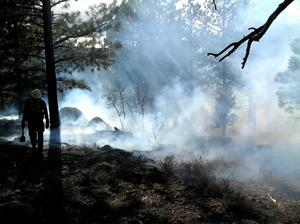
Eco-Dry excels at moisture management
You can hardly get through an evening news program without hearing about an out-of-control wildfire spreading across various parts of the country. But how safe - and comfortable - is the clothing being worn by the men and women fighting these fires? Researchers at North Carolina State University are working to develop and demonstrate new testing technologies for evaluating gear worn by wildland fire fighters t

14th July 2011
Innovation in Textiles
|
Raleigh, NC

You can hardly get through an evening news program without hearing about an out-of-control wildfire spreading across various parts of the country. But how safe - and comfortable - is the clothing being worn by the men and women fighting these fires?
Researchers at North Carolina State University are working to develop and demonstrate new testing technologies for evaluating gear worn by wildland fire fighters to protect against dangerous radiant, or non-direct, heat, while affording comfort and flexibility.
"Wildland fire fighters need clothing that provides better balance between comfort and thermal protection," says Dr. Roger Barker, director of the Textile Protection and Comfort Center (T-PACC) at NC State and lead researcher on the project.
"New flame-resistant fibres and fabrics have made fire fighting gear more thermally protective, but protective clothing can sometimes be uncomfortable to wear, particularly if fabric layers are added making the suit thicker and less breathable. We are not only concerned about the suit's ability to withstand heat from flames, but also the heat stress that comes from fire fighters having to wear suits that trap their body heat. This is a serious consideration, especially since they fight fires for hours, often in extreme weather conditions."
Barker's research lab, which includes state-of-the-art manikin PyroMan, has developed and tested turnout suits, boots, gloves and more over the years to improve first-responder safety. Housed in a large fire test chamber, the PyroMan system provides safe, controlled, repeatable exposures of flame threats.
PyroMan is a highly sophisticated instrument used to study garment and body reaction to intense heat and flames. A computerized analysis of sensor response indicates where and how severe potential tissue burns may be for the wearer. But since fire fighting gear for structural fires is different than for wildfires, protective tests also need to be different.
"With wildfires, we're not just talking about direct exposure to the flame, but also the radiant heat coming off flames. It's a different kind of exposure - we're exchanging less heat intensity for longer periods of exposure - so using PyroMan wouldn't help us in addressing the particular problems wildland fire fighters face," Barker explains.
As part of the study, Barker's team will be developing totally new technologies for evaluating the thermal protective performance of wildland fire fighter clothing materials, including an instrumented manikin that specifically looks at radiant heat, to be named, RadMan.
Unlike PyroMan, in which test garments are exposed to direct flame contact for three to 10 seconds, RadMan will be exposed to indirect radiant heat for longer times, up to several minutes.
RadMan, and other tests, will allow us to benchmark existing materials used in wildland clothing in an unprecedented way," Barker says. "We want wildland fire fighting garments to be as light and comfortable as possible, without giving up necessary protection."
In addition to RadMan, the team will use the full range of T-PACC's comfort research capabilities, including an advanced sweating manikin to measure the heat stress potential of wildland protective clothing.
As part of this phase of the research, wildland fire-fighters will participate in wear trials of gear in T-PACC's climate-controlled chamber to determine the level of comfort of various ensembles. The new testing methods and knowledge developed by Barker's team will be used to help the National Fire Protection Association develop updated standards for wildland fire fighter ensembles.
Barker's team received a $1 million, two-year grant from the Assistance to Firefighters Grant (AFG) Program to conduct this research. The AFG is a program of the Federal Emergency Management Agency at the Department of Homeland Security that provides funding for fire fighter safety research and development.
The AFP program supported Barker's team in a recent successful project to develop a better performing glove for use by structural fire fighters.

Business intelligence for the fibre, textiles and apparel industries: technologies, innovations, markets, investments, trade policy, sourcing, strategy...
Find out more